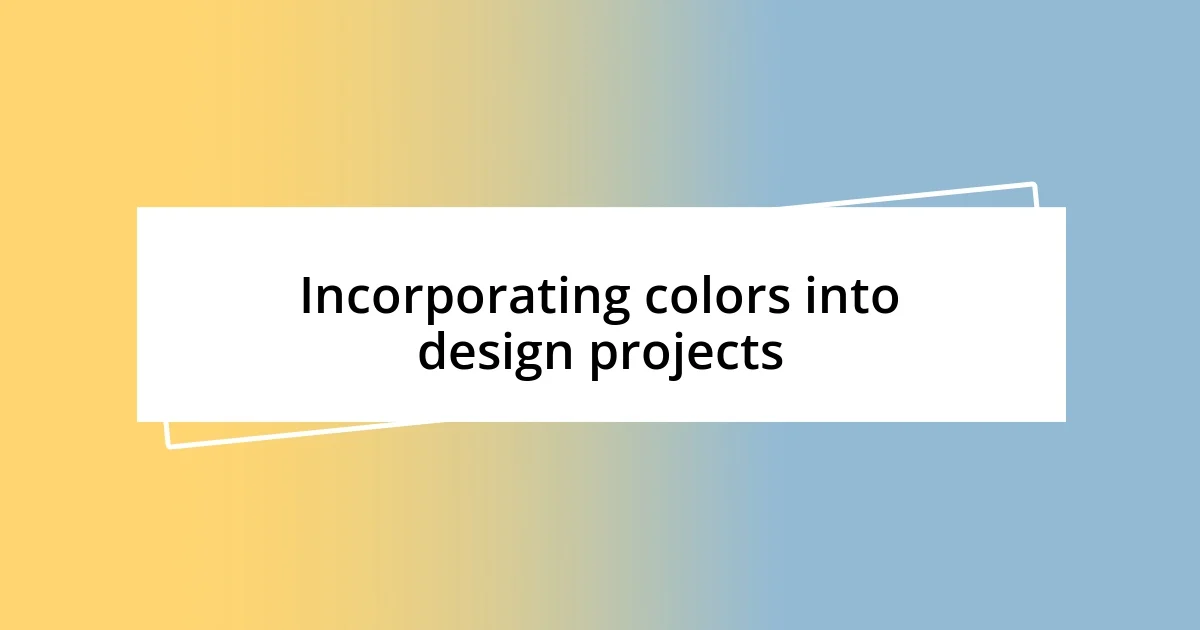Key takeaways:
- 2023 color trends emphasize a blend of soft pastels and rich hues, reflecting a desire for comfort and creativity.
- Key color predictions include vintage tones, jewel tones, and muted shades, each evoking specific emotions and atmospheres.
- Incorporating intentional color choices can transform spaces and enhance emotional connections, turning design into a narrative experience.

Understanding color trends for 2023
Color trends for 2023 reflect a vibrant tapestry of emotions and influences, emerging from our collective experiences over the past few years. I’ve found it fascinating how colors like soft pastels and deep, rich hues have become popular. They seem to reflect a desire for comfort while also pushing the boundaries of creativity—how do these colors make you feel when you see them?
One standout trend I noticed is the rise of nature-inspired palettes, such as terracotta and deep greens. I remember walking through a local botanical garden and feeling an overwhelming sense of peace amid the luscious foliage. These earthy tones not only create a calming atmosphere but also remind us of our connection to nature, don’t you agree? Incorporating these colors into my own space transformed it into a sanctuary.
Another intriguing aspect of 2023’s color trends is the boldness of neon accents. I used to shy away from bright colors, but when I painted a focal wall neon orange, it brought a burst of energy into my home office. It’s electrifying to think about how colors can empower us and evoke such strong emotions—what bold choices have you made in your color palette this year?

Key color predictions this year
As we look at key color predictions for this year, one striking trend is the resurgence of vintage tones, particularly shades like mustard yellow and dusty rose. I remember spotting a vintage sofa in a café with these colors, instantly transported to a cozy, nostalgic space filled with warmth. This combination isn’t just about aesthetics; it evokes a sense of familiarity and comfort that many of us crave in our fast-paced lives.
Additionally, jewel tones like sapphire blue and emerald green have made a significant comeback. I recently attended a gathering where the decor was drenched in these rich hues, and it created such an inviting atmosphere that I found myself mingling more than usual. The depth of these colors truly adds sophistication to any setting while also making a powerful statement. Have you noticed how some colors just seem to draw people in?
Finally, we cannot overlook the role of muted tones this year, such as soft taupe and muted lavender. These subtle shades can create a serene backdrop, perfect for creating spaces that promote relaxation. When I recently painted my bedroom a calming shade of lavender, it transformed my sleep environment into a restful retreat, proving that sometimes, less really is more.
| Color Trend | Description |
|---|---|
| Vintage Tones | Mustard yellow and dusty rose evoke warmth and nostalgia. |
| Jewel Tones | Sapphire blue and emerald green offer sophistication and depth in decor. |
| Muted Tones | Soft taupe and muted lavender create serene and relaxing environments. |

How to analyze color palettes
When it comes to analyzing color palettes, I often start by considering the emotional responses they evoke. For example, I recently experimented with a palette of coral and teal in my kitchen, and the immediate vibe was invigorating. It’s intriguing how certain combinations can elevate your mood and alter the way you interact with a space.
To break it down, here are some key steps I find useful in analyzing color palettes:
- Observe the Context: Look at where the colors are being used. Is it in nature, fashion, or design? The environment can influence how colors are perceived.
- Identify Emotions: Try to pinpoint what feelings the colors provoke for you. How does yellow make you feel compared to navy blue?
- Create Combinations: Don’t shy away from playing around with various contrasts and complements. I once combined a bold magenta with muted grey, and it surprisingly created a very balanced aesthetic in my home office.
- Test with Swatches: Visually assessing color swatches in different light can help. I always bring home paint samples before making a final choice—seeing how the colors change with daylight vs. evening light can be eye-opening.
In my experience, understanding the psychology of color really enhances the analysis process. There’s a personal story behind every shade I choose; for instance, the soft lavender in my guest room reminds me of my grandmother’s garden, evoking comfort every time a guest steps in. It’s this blend of emotional connection and thoughtful analysis that makes color selection an art form in itself.

Incorporating colors into design projects
Incorporating colors into design projects is truly where the magic happens. I remember when I was working on a friend’s coffee shop interior. We opted for a warm palette with pops of mustard yellow, which not only brightened the space but also created an inviting atmosphere that made customers want to linger over their lattes. Have you ever noticed how certain colors can make you feel more at home?
I’ve found that layering colors brings depth and dimension to any project. For instance, while redesigning my living room, I combined rich jewel tones with muted neutrals. This contrast created a dynamic space that felt both sophisticated and cozy. It was here that I learned the importance of balance. Too many bright hues can overwhelm, while too few can leave a space feeling flat. How do you balance colors in your designs?
Lastly, I approach color choices with a sense of storytelling. Each project reflects a narrative, whether it’s a serene bedroom painted in calming taupe or a vibrant office splashed with coral. During my last home office makeover, I chose a bold turquoise accent wall that sparks creativity every time I walk in. It’s fascinating how a single color can dictate the mood of a room, isn’t it? Making intentional color choices can transform not just the space, but also the experience of everyone who interacts with it.

Personal experiences with color adaptation
Adapting to color trends this year truly felt like an adventure for me. I decided to embrace the warming shades of terracotta and sage green throughout my home, and it was a game changer. Not only did these colors create a cozy atmosphere, but they also sparked a newfound enthusiasm in my daily routines. You know that feeling when a color just clicks with you? That’s what happened.
While revisiting my home office, I allowed myself to play with hues I wouldn’t typically choose. Incorporating a vibrant mustard yellow alongside soft grey not only invigorated the space but also encouraged a more creative flow during my workdays. I often wondered—how can such a simple change breathe new life into familiar surroundings? That bold move made me realize that color, even when daunting, has the power to transform our emotions and perceptions.
Reflecting on this journey, I’ve come to appreciate how personal adaptation to color trends can forge deeper connections to our spaces. There’s something uniquely profound about watching a once-dull room come alive with fresh colors. In choosing a calming pale blue for my bedroom, I didn’t just select a color; I selected tranquility—a quiet retreat from the chaos of everyday life. Have you ever selected a color with that level of intention? It’s an experience worth exploring.














